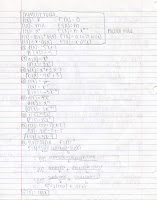
If the main concept yesterday (Tuesday) was the definition of the derivative, today's main idea was how to best calculate a derivative. It is important that you always keep in mind that the derivative is defined to be the limit of the slope between points, but we will rarely (never) use the limit definition to find the derivative of a function.
For now it's all about the Power Rule. Examples are included of how to apply the Power Rule even when it isn't immediately obvious.
Thanks again to Rachel for providing her notes for today.



































